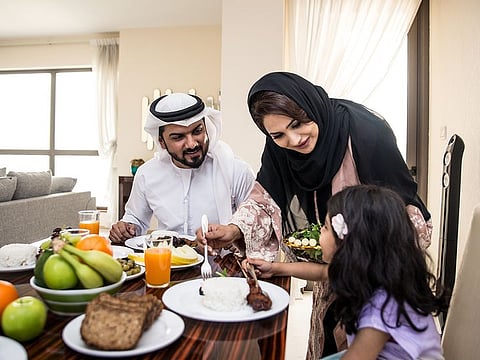7 Emirati dishes made healthier
This UAE National Day, why not put a healthy spin on some traditional UAE foods?

Staples of the Bedouin diet such as camel milk and dates have been hailed for their nutritive value, but many traditional Emirati dishes do not rank as highly, partly because many are occasion-specific festive staples.
UAE researcher Ayesha Al Dhaheri looked at the glycaemic index of several traditional Emirati foods for a small study that was published in the journal BMC Nutrition. The metric tracks scores foods according to their impact on blood glucose levels. Eating many foods with a high GI score can lead to more frequent snacking and a greater risk of obesity and diabetes. The 2015 paper studied five dishes: chicken thareed and chicken margoogat (both stews), aseedah (a common breakfast food), gurus (a kind of fried bread) and sago pudding. All had a high glycaemic index, but this value can be modified through altering the ingredients, cooking method, or the portion size, the researcher wrote.
Decades ago, people in the UAE ate a diet rich in seafood, meat, grain, and dairy, with only those vegetables and fruits that could be cultivated in the harsh climate. “The main staples of the typical traditional Emirati diet are rice, fish, red meat, spices, and dates,” says Sabina Nassar, a DHA-licensed dietitian. Grilled meats and vegetables and one-pot meals were common.
But many traditional recipes were also dense in calories and fat, in response to the climate, to fuel an active lifestyle, where local residents often needed to walk long distances. “Foods were rich in calories and fats, but these choices were justified by the nutritional requirements of the community at that time – primarily fishermen and pearl divers,” says Farheen Dhinda, a Clinical Dietitian at Dubai Health Authority (DHA). She agrees that with a few simple tweaks, these classic recipes can be made healthier, with an improved nutrition profile and a lower carbohydrate count.
“To make Emirati foods as healthy as possible, I would suggest reducing the amount of oil or butter that’s added while cooking to the minimum level needed,” Nassar adds. She suggests considering the macronutrients in a meal and balancing out the overall profile to put the emphasis on vegetables, which are rich in nutrients and fibre and should comprise half your plate in line with DHA guidelines. “Remember also to control and decrease the amount of sugar added into desserts and depend more on the natural sugars coming from the dates or other fruit.”
In time for UAE National Day, here are a few classic Emirati dishes, some healthy and others adjusted for modern lifestyles.
1. Balaleet:
The sweet and savoury breakfast item is popular across the Arabian Gulf. Vermicelli is fried and then cooked to al dente is tossed in butter and sugar, and served with an omelette, and optionally, sautéed onions or potatoes. To improve its health quotient, Nassar suggests boiling the vermicelli directly without frying it beforehand and using a minimum of butter and sugar – or even swapping the butter for olive oil.
2. Samak Mashwi:
Eaten across the Arabian peninsula, grilled fish is classic local fare, and possibly one of the healthiest items on the Emirati table. At it’s best, the fish is cooked within a few hours of being caught – it isn’t uncommon to find customers at traditional fish markets across the country asking for a choice specimen to be cooked for immediate consumption. “This simple Emirati dish uses freshly available fish and minimal spices in order to make nutrient dense and provide your diet with a healthy source of protein,” Dhinda says.
3. Margoogat:
This tomato-based meat stew is cooked with local spices such as cumin and turmeric. Although different families have their own recipes, almost all cook it or serve it with bread. “Switching red meat with lean meat like chicken and adding a variety of vegetables in the stew can make this dish a healthy addition to your daily diet,” Dhinda says. Don’t forget to use a healthy bread, too.
4. Harees:
A winter and Ramadan staple, harees is a porridge of wheat and meat, cooked with plenty of ghee and often finished with sugar. “To reduce the calories and saturated fat it is best to eliminate or reduce the ghee added on top of the dish as much as possible,” Nassar says. “In addition, if it’s a chicken harees make sure to remove the chicken skin before cooking; if it’s lamb, remove as much white fat as possible from the lamb and use lean cuts.”
5. Machboos:
One of the most popular dishes in the UAE, machboos is a dish of rice and chicken, lamb, or seafood. Similar to biryani, it often has plenty of ghee and the meat is often fried – although the Sheikh Mohammed Centre for Cultural Understanding recommends just browning the chicken. “Again, use as little ghee as possible and use lean cuts of lamb or skinless chicken,” Nassar says. “For chicken machboos, I recommend grilling the chicken instead of frying it.”
6. Kebab:
In terms of health, you could do a lot worse than the classic Emirati grilled staple but there are ways to improve its nutritional quotient. “Using lean cuts of the meat is one of the best ways to make your already healthy kabab healthier,” Dhinda says. “Combine this with a generous portion of steamed vegetables or salad and a small portion of whole wheat bread to make this a wholesome meal.” And go easy on the oil or fat while cooking.
7. Rangeena:
A stovetop date cake made with refined wheat flour, ghee, and dates; this Emirati teatime treat is an indulgence indeed. Minimise any damage by using wholewheat flour or oat flour instead and try replacing ghee with olive oil, Nassar says. “Try not to add sugar and just enjoy the natural sweetness from the dates.”
Sign up for the Daily Briefing
Get the latest news and updates straight to your inbox



